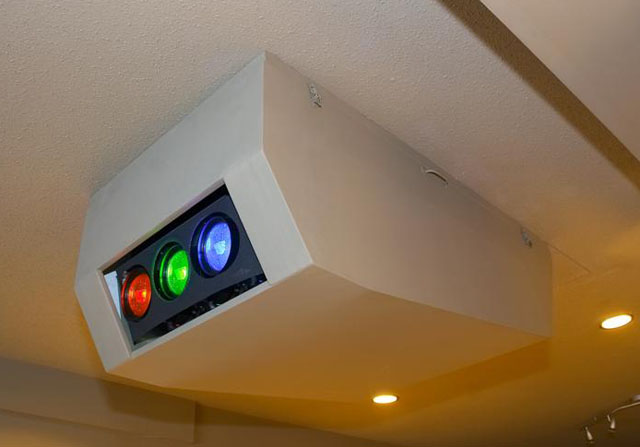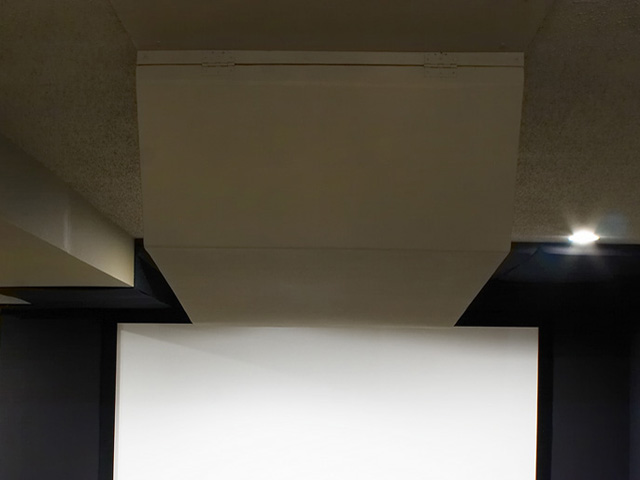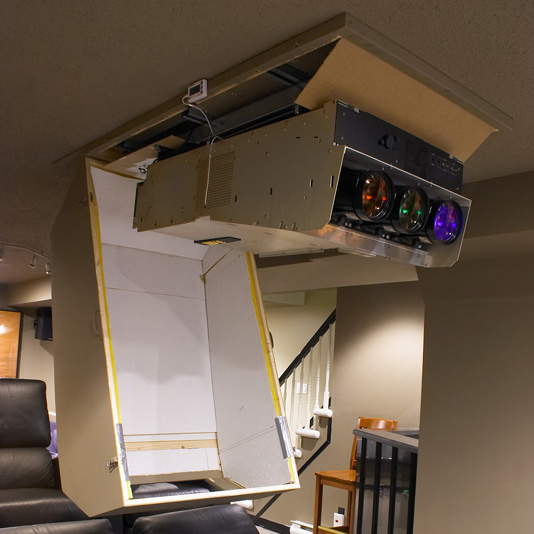Once the insulation is installed, caulk, sand, prime, and paint the hushbox
to suite your home theater:

You may now wish to install a couple of handles (as seen in the photo above) to
make the hushbox easier to handle. While it’s light, it’s fairly awkward to
handle so the handles help out a lot.
Four (4) draw latches are used to connect the hushbox to the 2x2” frame. The
latches allow quick and easy access to the projector without use of tools or a
helper. A safety feature of these latches is that one must lift up with enough
force to lift the box up before the loops will release. It won’t accidentally
drop even if one pops the latches loose.
Two (2) hinges are used at the back to allow the box to swing down when the
projector needs to be accessed (which is fairly rare).

A small stove temperature probe with an audible alarm (little white box seen in
the photo below) is placed inside of the projector to alert me if ever the warm
air exhaust system fails.

The hardest part about hushboxes is venting (especially if the ceiling's already
in place). Proper venting through a large diameter vent is critical. I often see
people ask "what's the max temp I can run my projector at?". As stated earlier,
the cooler you run the projector, the longer it will last and the better it will
run. There's no "max" temp really. The higher the temp the sooner the components
in the projector will fail. It may take a couple of years but it *WILL* fail
sooner and be problematic if you don't cool it adequately. Get it running as
close to ambient room temp as you can and your projector will thank you with a
long problem free life and stable convergence.
Case in point: I ran the projector (a Zenith 1200, aka Barco Cine 8 Onyx) for a
couple of weeks without the hushbox just to see how warm it would get inside so
I had some baseline to compare against. It averaged about 28 degrees Celsius
right behind the green CRT socket. With the hush box in place this temp is 2-3
degrees Celsius cooler! Proves that pulling air through the box and out the back
is actually working better than the standalone projector (one reason being that
a ceiling mounted projector tends to re-circulate the warm air that collects at
the ceiling while this solution completely removes the warm air from the room).
| Did you find this information useful? Please consider making a
donation to help defray the cost of managing and hosting future
articles, tips, and documents. |
|
|
|
Or
purchase
from
Amazon.com
and a small percentage automatically
goes to support this site at no extra cost to you! Visit their
Blu-ray and
4K UHD
stores for sales.
Want to show off your
home theater? See our
Blu-ray Release List & Must-Have Titles. |
|

|
|

|






